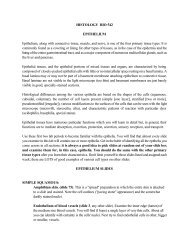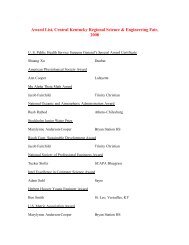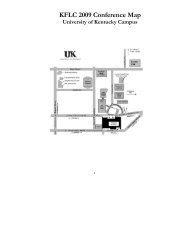Linear Transformations and Combinations
Linear Transformations and Combinations
Linear Transformations and Combinations
Create successful ePaper yourself
Turn your PDF publications into a flip-book with our unique Google optimized e-Paper software.
We will not go through the proofs on how to compute the mean <strong>and</strong> variance of a linear<br />
combination, but they are similar to the formulas for a linear transformation of a single r<strong>and</strong>om<br />
variable. The mean of a linear combination is<br />
E[a1X1 + a2X2 + . . . + anXn + b] = a1E[X1] + a2E[X2] + . . . + anE[Xn] + b<br />
so the expectation of a linear combination is the same linear combination of the expectations.<br />
If all the r<strong>and</strong>om variables in the linear combination are independent (don’t forget<br />
this assumption), then the variance of a linear combination is<br />
V [a1X1 + a2X2 + . . . + anXn + b] = a 2 1V [X1] + a 2 2V [X2] + . . . + a 2 nV [Xn]<br />
Two simple linear combinations of two independent r<strong>and</strong>om variables are Z1 = X + Y <strong>and</strong><br />
Z2 = X − Y , where X <strong>and</strong> Y are independent. These may be written Z1 = 1X + 1Y + 0 <strong>and</strong> Z2 =<br />
1X + (−1)Y + 0. Using the formulas, we may derive E[Z1] = E[X] + E[Y ], E[Z2] = E[X] − E[Y ],<br />
<strong>and</strong> V [Z1] = V [X] + V [Y ], V [Z2] = V [X] + V [Y ]. Note that while the variance of a sum is the sum<br />
of the variances, the variance of a difference is also the sum of the variances. If we add independent<br />
sources of noise into a problem, we increase the overall noise of the system.<br />
4 Examples<br />
4.1 Tables <strong>and</strong> Chairs<br />
At a school, each room contains only tables <strong>and</strong> chairs. Suppose that, on average, each room<br />
contains 50 chairs with a st<strong>and</strong>ard deviation of 20 chairs. Suppose further that, on average, each<br />
room contains 5 tables with a st<strong>and</strong>ard deviation of 2 tables. Each chair weighs 10 pounds <strong>and</strong><br />
each table weighs 30 pounds. You select a r<strong>and</strong>om room <strong>and</strong> place all the items in the room into<br />
a 10000 pound truck.<br />
a) Write a formula for Z, the total weight of the truck <strong>and</strong> its contents after the truck has been<br />
loaded with the contents of the room. Z = 10C + 30T + 10000<br />
b) What are the mean <strong>and</strong> variance of Z? E[Z] = 10E[C] + 30E[T ] + 10000 = 10(50) + 30(5) +<br />
10000 = 10650. V [Z] = 10 2 V [C] + 30 2 V [T ] = 10 2 (20 2 ) + 30 2 (2 2 ) = 43600<br />
4.2 Christmas Donations<br />
Each year at Christmas, charity donations are accepted at a local grocery chain. Suppose the<br />
chain donates an initial $100 <strong>and</strong> then customers donate either in Lexington or in Nicholasville. In<br />
Nicholasville, customers donate an average of $2100 each year with a st<strong>and</strong>ard deviation of $100,<br />
while in Lexington customers donate an average of $5500 with a variance of 90000. Suppose further<br />
that the local grocery chain matches the donations. For every dollar donated in Nicholasville, the<br />
local grocery chain gives an additional $0.25 <strong>and</strong> for every dollar donated in Lexington the local<br />
grocery chain gives an additional $0.50. What are the mean, variance, <strong>and</strong> st<strong>and</strong>ard deviation of<br />
the total amount of donations to the charity in a given year?<br />
When we look at this problem, the mean <strong>and</strong> variance are given for two r<strong>and</strong>om quantities.<br />
These are the amount donated by customers in Nicholasville (N) <strong>and</strong> the amount donated by<br />
3









